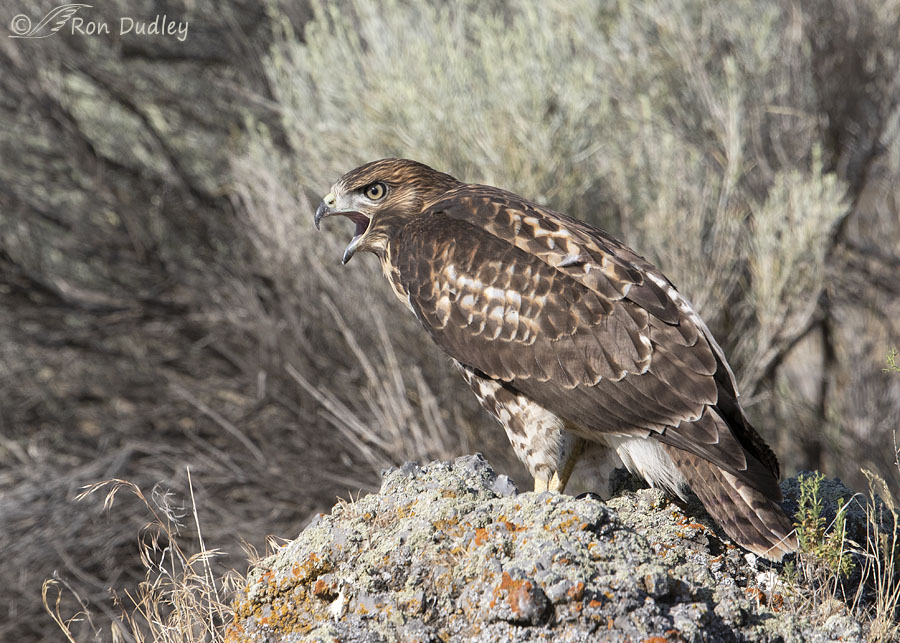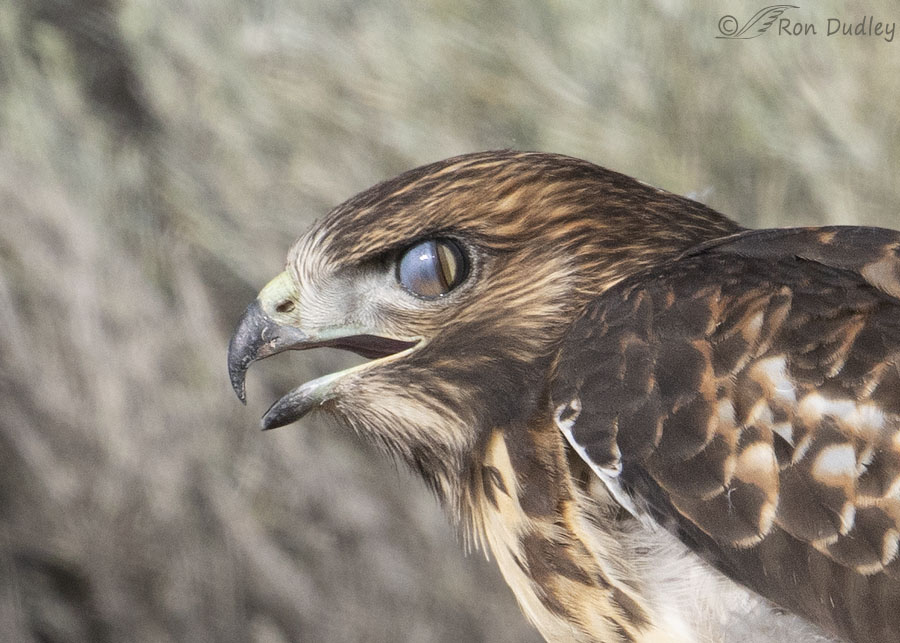Plus a close up look at the nictitating membrane in action.

1/1250, f/9, ISO 640, Canon 7D Mark II, Canon EF 500mm f/4L IS II USM + EF 1.4 III Extender, not baited, set up or called in
This is one of the young Red-tailed Hawks I spent quite a bit of time with earlier this summer. The photo was taken on July 12 as ‘he’ was calling out, probably to be fed by one of his parents.
Typically I’d take a shot like this at f/6.3 but his body was turned slightly away from me causing his tail to be a little closer to me than his head. I wanted to get him sharp from stem to stern so I took this and a few other shots at f/9 to give me more depth of field. I was willing to sacrifice shutter speed because I was too close for takeoff shots anyway. I’m happy with the results.
Last night I was looking at this photo and lamenting the fact that we can’t see his feet so I scrolled through other photos of this bird to see if I had any where his feet can be seen. I don’t but two shots in the burst later. as he was closing his mandibles after calling out, I found a sharp, detailed and interesting photo of his mostly closed nictitating membrane.
So as I’m prone to do I cropped tightly on it to see what I could see.

The nictitating membrane (nictitans, from Latin nictare, to blink) is a transparent, or more often translucent, membrane that can move horizontally across the eye. It’s often called a 3rd eyelid. Fully developed nictitans are found in many fish, amphibians, reptiles, birds and mammals but are rare in primates.
-
- The membrane has a variety of functions including protection and moistening the eye while maintaining at least some vision.
- A tear gland (Harder’s gland) attached to the membrane of some vertebrates produces up to 50% of the tear film.
- One informal name for the nictitans is “the blinker”. I like that.
- In many animals the closing of the membrane is strictly a reflex action but birds can actively control their nictitans.
- Raptors tend to close their membranes while feeding chicks to protect their eyes, Peregrine Falcons close them during their incredibly fast stoops to clear debris and spread moisture across the cornea and woodpeckers tighten their membranes a millisecond before their bill impacts the trunk of a tree to prevent shaking-induced injury to their retinas.
I’ve discussed the nictitans in several posts over the years but when I get a good, clear closeup photo of the membrane I’m always tempted to do it again.
After all, repetition is one of the keys to learning.
Ron
Note: These photos were taken in the morning with the sun low in the sky so notice that I have a catch light in the second photo, even with the membrane mostly closed.
That photo gives us a good look at something else that affects the ability of photographers to get catch lights in raptors – their overhanging brow ridge. Later in the day with the sun higher in the sky it’s much more difficult to get light in the eyes of diurnal raptors than it is in other birds because the brow ridge prevents direct sunlight from reaching the cornea.


Thank you for explaining when the birds use the membrane and for capturing it half-closed. Or is that half-open…
Such beautiful shots, Ron! The second shot of the nictitating membrane is fascinating!
Thank you, Marty.
True Ron – I have had otherwise excellent eagle photos ruined due to the membrane – glad you mentioned that
Astounding photo of the nicitating membrane, Ron. Especially since you weren’t intentionally photographing it. The detail is fascinating: the pupil can be seen through the nictitans; one wonders how well they see through it. Layers of the membrane can even be seen. Never heard of the Harder’s gland. Cool stuff. Thank you.
Thanks, Lyle. I believe that once the membrane becomes stretched fully across the eye it’s probably a little easier to see through.
Colour me fascinated. Again. And huge thanks to both you and your knowledgeable commentators.
As an aside, if anyone ‘asking’ me for food had the penetrating gaze of the young red-tail I would jump to it. Even without the advantage of that membrane to protect me.
I’m glad you were fascinated, EC. Thanks.
Love those close ups and slices of time, and yeah, redtails 😉 Just lovely!
When the veterinarian opthalmologist professor at Cornell was examining Mariah’s injured right eye, I got to play Stump the Vet Student on the issue that raptors control their eye movements. I used to know the names for their abilities versus ours, but I’ve slept since then. Stuff falls out. ANYWAY, the question the professor asked was why humans need only an eye drop solution to expand their pupils for examination and raptors need to be anesthetized. It took them a while to come up with the correct answer! I was jumping up and down, “I know! I know!” LOL!
Oh and THANKS to Dan Gleason, too!
Thanks, Laura. That’s a fun story. And an interesting practical application of a bit of knowledge about the nictitans.
Very nice close up and information. I hope the young are thriving!
Thanks, April. I hope so too.
Well, of course, there’s the beautiful young hawk to fall in love with — and then there’s all the good info about that “third eyelid.” Your close crop of it makes me think of a cat’s eye marble — where that name came from, I now realize. Though as a kid growing up with lots of cats, I can’t say as I ever thought about or noticed it in a single one of them! 🙀
Chris, this from Wikipedia probably explains why you never noticed them in cats.
“The nictitating membranes in cats and dogs do not have many muscle fibers, so they are not usually visible; chronic visibility should be taken as a sign of poor condition or ill health. It can, however, be seen clearly when gently opening the eye of the healthy animal when it is asleep, or pushing down/applying pressure on the eyeball, which will cause it to appear. In some breeds of dogs, the nictitating membrane can be prone to prolapse of the gland of the third eyelid, resulting in a condition called cherry eye.”
Huh! Well, #1, glad to know it isn’t that I was entirely unobservant as a child with all those cats, and #2, I appreciate your Wiki search to clarify. Once a teacher, always a teacher! 😻
Super shots Ron! What an incredible shot of its nictating membrane!
Thank you, Charlotte.
The nictitans is an interesting structure, but often not noticed by many people. It may serve different purposes. Magpies have an orange spot on the membrane that is used in some displays. Young males often show it while assessing one another. In this case, usually only the eye on the side facing another male will blink this membrane. Unlike many animals, birds can control each eye membrane separately. Many other kinds of animals also have this membrane, including many mammals. It is absent in primates. Many people think it is easiest to see in American Dippers as they see the white flash across the eye as the bird emerges from the water or as it stands at the water’s edge. However, in this case, that white is not the nictitans but the upper eyelid which comes from the top down, not horizontally. Their nictitans is beneath that as in all other birds. Why they flash it is a mystery.
Dan, I often see magpies flashing their membranes for apparent communication purposes but I didn’t know about the orange spot. I’ll have to see if I can catch it in my photos of them. Thanks for another very enlightening comment.
So interesting! Thank you Ron for providing my next virtual cocktail party tidbit ‘nictating membranes.” Fascinating!!
I’m always happy to contribute to booze parties, Kathleen! Virtual or not.
Thanks for these beautiful photos and the info. I appreciate the photography tips, but I enjoy even more learning about birds. I didn’t know about nictating membranes before I started following you. Or that American Goldfinches have been known to eat insects! What amazing creatures birds are!
Good. Then at least some of this stuff I talk about does some good. 🙂 Thanks, Sheila.
Excellent!m A great catch. I always save the photo if I’m lucky enough to catch the membrane in motion. Photography of birds is a series of lessons…every once in a while you catch the unusual that prods you on to learn more. Having a good blog to read really helps…like why I didn’t think of the brow ridge and lack of catch lights during certain times of the day for raptors.
Kathy, that time of day thing with diurnal raptors makes a huge difference!
Neat! Those that aren’t aware of the nictitating membrane, including me when younger, are “sure” there is something wrong – sometimes there is BUT! 🙂 Glad you could capture it partly closed and, as always the tutorial on when it’s used is welcome……. Beautiful bird! 🙂
Good point, Judy. It CAN mean something is wrong, especially in cats, but usually everything’s fine.
Know that on cats………
Excellent photo – you got the membrane in the process of nictitating. That is really neat. I have closeup photos of our eagles where the membrane is either open or closed, but never in the process. Always like your Red-tailed Hawk photos. I have been recently taking photos of a fully grown juvenile who is so active he or she is just so much fun to watch.
Some photographers, including me at times, curse the membrane because it can “ruin” an otherwise excellent photo when it’s closed. But I find it to be such an interesting structure I try to not let it bother me too much. Thanks, Everett.